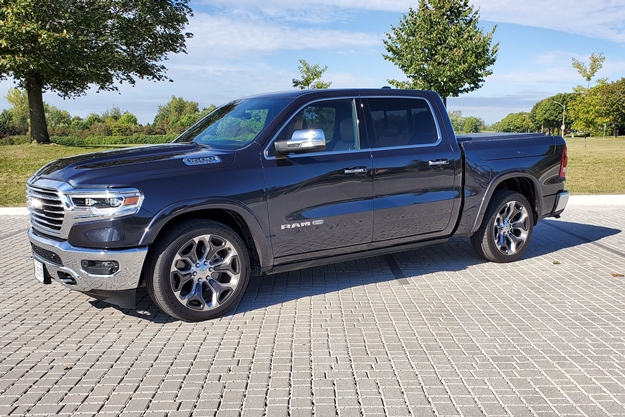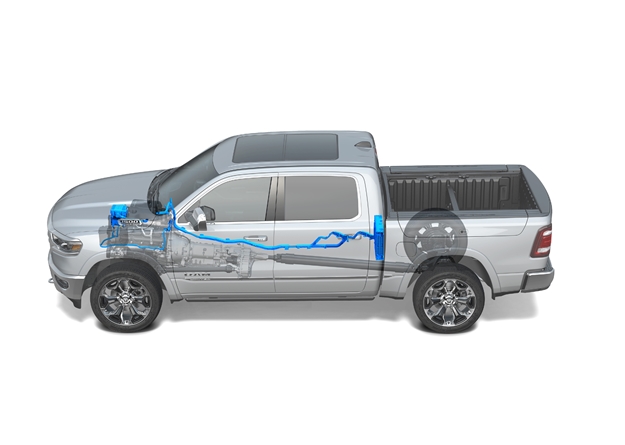As a child, whenever I rode my bicycle, I usually took notice of which way the wind was blowing. If I had to ride to the store to pick up something for my Mom and there was a breeze blowing in my face, I learned over time that it was harder to get there because of the breeze. But by the same token I also knew that the ride home would be easier because that same breeze was behind me, almost assisting me a bit so that I didn’t need to use as much energy on the ride back.
I think of my time riding a bike with a breeze at my back whenever I get a chance to drive a vehicle with what is known as e-Assist technology, such as I did recently with a new 2019 Dodge Ram 1500, Longhorn Crew Cab 4×4. This somewhat over-the-top pick up with an interior that made me feel more like I was rounding up cattle than trudging along Highway 401, was equipped with a traditional 5.7L V8 Hemi. But connected to the engine was a little bit of technology in the form of a small 48-volt, 0.4 kWh lithium ion battery, which in Ram’s case is known as eTorque. The electrification is much too little to identify this system as a traditional hybrid, but then nowhere on the vehicle or in the literature does it ever claim to be one. In fact, there wasn’t anything on the exterior of the vehicle to indicate there was any sort of different powertrain inside at all.
This eTorque technology is actually standard on 2019 Ram 1500’s with the updated Pentastar V6 engine, and is available as an update with the Hemi. The goal of course is to improve fuel economy on a vehicle that really has little reason to be seen as anything other than what it truly is – a big truck with a big engine. Doing so has to be done subtly as Ram buyers are brand-attached to the core values that Ram brandishes of being built tough. I mean any truck that is shown in ads to be scaling a rugged mountain top that has no roads and no place to level off, is clearly being targeted at those who don’t want to know there are tiny electric motors buried in back and helping to push it along.
And make no mistake, the eTorque technology is indeed subtle. Unlike traditional hybrids that can often run on battery only for limited stretches, eTorque systems just don’t offer enough power to do that. Instead, much as its name implies the small amounts of additional power, which in the case of the Hemi-equipped variant adds about 16 horsepower and 49 lb-ft of torque are there to assist the Hemi in certain optimal situations. It’s also small enough to fit behind the 2nd row of seats while not reducing internal dimensions at all.
Perhaps the best illustration comes with the start/stop technology the eTorque is paired to. With most auto stop/start systems you can actively feel the re-engagement of the motor when beginning to drive again from a full stop. With the eTorque the vehicle actually begins to move thanks to the charge coming from the small battery, and when the engine re-engages the vehicle is already rolling. The end result is one of the most undetectable start/stop systems out there, but at the same time one that helps to improve fuel economy overall. Given that it takes a large amount of energy to take any vehicle weighing thousands of pounds from a stopped to a moving position, the more that this energy can be derived from a battery and not from a gas engine, the better one can expect fuel economy to be.
The eTorque system also works with the gas engines in other, very subtle ways but they are virtually undetectable to even someone like me who spent an entire week trying to notice the eTorque system with every chance I could.
So, with such a minor system in place, can one really expect big improvements in fuel economy? Well, not really. According to the numbers posted on Natural Resources Canada’s 2019 Fuel Economy ratings publication, the 5.7L Hemi 4×4 without eTorque is 13.8 L/100 KM, while the eTorque version comes in at 12.9 L/100 KM. That amounts to an improvement of about 6.5%, which can be seen as both positive and negative.
If the goal is to basically sneak in a system that burns less gas without anyone buying the vehicle even knowing it was there, then shaving 6.5% is indeed a bonus. But if driving a truck is your thing yet you also want to also cut down on your gas mileage as much as possible, there are better options both currently available and coming shortly.
The Ram 1500 Eco Diesel offers around 25-30% fuel consumption improvements compared to regular gas models, so if you’re looking to stick with Ram and don’t mind driving a diesel then to me it’s the better choice.
But the electrification of trucks is coming. Ford’s next-gen F-150 will come with hybrid-electric and even a full-electric variant on offer. General Motors has also announced its plans for a full electric pick up soon, and while it looks far more sci-fi than off-roader, one cannot ignore the launch of the Tesla Truck and its quarter of a million pre-order deposits so far.
FCA has been very slow to the electrification game to this point. A compliance Fiat e500 in California and a really good PHEV Chrysler Pacifica have been all that North Americans have seen so far from the automaker. Europe will see a PHEV Wrangler soon, but no word on when we’ll see it in North America just yet.
If there are plans for the Ram 1500 to boost up to a gas-electric hybrid, PHEV or full EV, those plans remain a secret. So, in the interim the eTorque variants will do what it can to sip less fuel while still keeping the RAM branding as big truck cool.
And if you want to burn even less gas, pay attention to which way the wind is blowing.



Leave a Reply